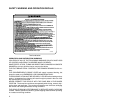S Always follow proper procedures for going down hills and for braking on hills as
described in this manual. Check the terrain carefully before you start down any
hill. Never go down a hill at high speed. Avoid going down a hill at an angle
which would cause the vehicle to lean sharply to one side. Go straight down the
hill where possible.
S Always follow proper procedures for crossing the side of a hill as described in
this manual. Avoid hills with excessively slippery or loose surfaces. Never at-
tempt to turn the vehicle around on any hill until you have mastered the turning
technique described in this manual on level ground. Avoid crossing the side of
a steep hill if possible.
S Always use proper procedures if you stall or roll backwards when climbing a hill.
To avoid stalling, maintain a steady speed when climbing a hill. If you stall or roll
backwards, follow the special procedure for braking described in this manual.
Dismount on the uphill side or to either side if pointed straight uphill. Turn the
vehicle around and remount, following the procedure described in this manual.
S Always check for obstacles before operating in a new area. Never attempt to
operate over large obstacles, such as large rocks or fallen trees. Always follow
proper procedures when operating over obstacles as described in this manual.
S Always be careful of skidding or sliding. On slippery surfaces, such as ice, go
slowly and be very cautious in order to reduce the chance of skidding or sliding
out of control.
S Never operate vehicle in fast flowing water or in water deeper than that specified
in this manual. Remember that wet brakes may have reduced stopping ability.
Test your brakes after leaving water. If necessary, apply them lightly several
times to let friction dry out the pads.
S Always be sure there are no obstacles or people behind you when you operate
in reverse. When it is safe to proceed in reverse, go slowly. Avoid turning at
sharp angles in reverse.
S Always use the size and type tires specified in this manual. Always maintain
proper tire pressure as described on page 83.
S Never modify this vehicle through improper installation or use of accessories.
S Never exceed the stated load capacity for this vehicle. Cargo should be proper-
ly distributed and securely attached. Reduce speed and follow instructions in
this manual for carrying cargo or pulling a trailer. Allow greater distance for brak-
ing.
S Always wear the seat belts whenever the vehicle is operated. This will reduce
the severity of injury in case of a sudden stop or collision.
S Always keep arms and legs inside of cab frame while the vehicle is in motion.
S Always apply the parking brake before getting out of the vehicle. The parking
brake is located on the left side of the center console. Activate by pulling up on
the lever. Release by pressing the button on the end of the handle and lowering
the lever.
S Always activate the foot pedal brake before releasing the park brake.
S Always shut off the engine before refueling. Make sure the area is well venti-
lated and free of any source of flame or sparks. Gasoline is very flammable.
See page 24 for refueling instructions.
FOR MORE INFORMATION ABOUT SAFETY, call Polaris at 1-800-342-3764.


















